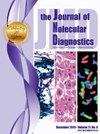Development of a Clinically Applicable High-Resolution Assay for Sperm Mosaicism
IF 3.4
3区 医学
Q1 PATHOLOGY
引用次数: 0
Abstract
Sperm mosaicism, the presence of a pathogenic variant in a subset of sperm, is an important cause of heritable genetic disease. However, clinical testing for sperm mosaicism outside research has been limited by the lack of Clinical Laboratory Improvement Amendments (CLIA)–validated results deliverable to patients. We developed the Sensitive Assay for Mosaicism (SAM), a two-phase method for sperm mosaicism detection. In phase 1, sperm DNA undergoes deep sequencing using next-generation sequencing or nanopore-based sequencing with unique molecular identifiers (UMIs) to improve accuracy. In phase 2, PCR primers specific to UMI sequences generate amplicons for CLIA-validated Sanger sequencing, providing patient-ready results. SAM's performance was characterized and tested on semen samples from 14 participants, each with a prior offspring with a de novo pathogenic variant. SAM demonstrated a detection limit of approximately 0.005%. The UMI strategy improved sequencing accuracy on next-generation sequencing and nanopore platforms from 99.9% to >99.999%, and from 93% to >99.99%, respectively. Sperm mosaicism was identified in two tested cases: FAM111A (5.51%) and FGFR3 (0.0129%), with FGFR3 exhibiting selfish mutation validated in unrelated individuals showing varying mosaicism levels. SAM provides sensitive detection of low-level sperm mosaicism with CLIA-validated results for patients, enabling recurrence risk assessment and guiding risk mitigation strategies such as in vitro fertilization with preimplantation genetic testing for monogenic disease, sperm donation, and prenatal diagnosis.
一种临床适用的高分辨率精子嵌合检测方法的开发。
精子嵌合是指精子中存在致病变异体,是遗传性基因疾病的一个重要原因。然而,由于缺乏临床实验室改进修正案(CLIA)验证的结果,在研究之外的精子嵌合临床检测一直受到限制。我们开发了 "精子嵌合体敏感检测法(SAM)",这是一种分两个阶段检测精子嵌合体的方法。在第一阶段,使用下一代测序(NGS)或基于纳米孔的测序技术对精子DNA进行深度测序,并使用独特的分子标识符(UMI)来提高准确性。在第二阶段,与 UMI 序列特异的聚合酶链式反应 (PCR) 引物会产生用于 CLIA 验证的桑格测序的扩增子,为患者提供可立即使用的结果。对 14 名参与者的精液样本对 SAM 的性能进行了鉴定和测试,每名参与者的前代都有一个新的致病变体。SAM 的检测限为 0.005%。UMI策略将NGS和纳米孔平台的测序准确率分别从99.9%提高到>99.999%和从93%提高到>99.99%。在两个测试病例中发现了精子嵌合现象:FAM111A(5.51%)和FGFR3(0.0129%),其中FGFR3表现出 "自私 "的突变,在无关个体中得到验证,显示出不同的嵌合水平。SAM能灵敏地检测低水平精子嵌合,并为患者提供CLIA验证结果,从而评估复发风险并指导风险缓解策略,如体外受精(IVF)与单基因遗传病植入前基因检测(PGT-M)、精子捐赠和产前诊断。
本文章由计算机程序翻译,如有差异,请以英文原文为准。
求助全文
约1分钟内获得全文
求助全文
来源期刊
CiteScore
8.10
自引率
2.40%
发文量
143
审稿时长
43 days
期刊介绍:
The Journal of Molecular Diagnostics, the official publication of the Association for Molecular Pathology (AMP), co-owned by the American Society for Investigative Pathology (ASIP), seeks to publish high quality original papers on scientific advances in the translation and validation of molecular discoveries in medicine into the clinical diagnostic setting, and the description and application of technological advances in the field of molecular diagnostic medicine. The editors welcome for review articles that contain: novel discoveries or clinicopathologic correlations including studies in oncology, infectious diseases, inherited diseases, predisposition to disease, clinical informatics, or the description of polymorphisms linked to disease states or normal variations; the application of diagnostic methodologies in clinical trials; or the development of new or improved molecular methods which may be applied to diagnosis or monitoring of disease or disease predisposition.

 求助内容:
求助内容: 应助结果提醒方式:
应助结果提醒方式:


